A Frequency-Reconfigurable Filtenna for GSM, 4G-LTE, ISM, and 5G Sub-6 GHz Band Applications
Abstract
1. Introduction
2. Antenna Design Methodology
2.1. Antenna Geometry
2.2. Antenna Design Methodology
2.2.1. Filtering Antenna
2.2.2. Frequency-Reconfigurable Filtering Antenna
3. Result and Discussion
3.1. Measurement Setup
3.2. Reflection Coefficient of the Antenna
3.3. Conformal Analysis of the Filtenna
3.4. Far-Field Parameters
4. Comparison with State-of-the-Art Antennas
5. Conclusions
Author Contributions
Funding
Institutional Review Board Statement
Informed Consent Statement
Data Availability Statement
Conflicts of Interest
References
- Kolluru, D.S.; Reddy, P.B. Review on communication technologies in telecommunications from conventional telephones to smart phones. AIP Conf. Proc. 2021, 2407, 020003. [Google Scholar]
- Park, J.H.; Lee, M.Q. Harmonic dual-band diode mixer for the X-and K-bands. J. Electromagn. Eng. Sci. 2021, 21, 64–70. [Google Scholar] [CrossRef]
- Chowdhury, M.Z.; Shahjalal, M.; Hasan, M.K.; Jang, Y.M. The role of optical wireless communication technologies in 5G/6G and IoT solutions: Prospects, directions, and challenges. Appl. Sci. 2019, 9, 4367. [Google Scholar] [CrossRef]
- Basit, A.; Khattak, M.I.; Althuwayb, A.; Nebhen, J. Compact tri-band bandpass filter based on asymmetric step impedance resonators for WiMAX and RFID systems. J. Electromagn. Eng. Sci. 2021, 21, 316–321. [Google Scholar] [CrossRef]
- Abbas, A.; Hussain, N.; Jeong, M.-J.; Park, J.; Shin, K.S.; Kim, T.; Kim, N. A Rectangular Notch-Band UWB Antenna with Controllable Notched Bandwidth and Centre Frequency. Sensors 2020, 20, 777. [Google Scholar] [CrossRef] [PubMed]
- Sung, Y. Simple patch antenna with filtering function using two U-slots. J. Electromagn. Eng. Sci. 2021, 21, 425–429. [Google Scholar] [CrossRef]
- Wu, K.; Andrew Zhang, J.; Huang, X.; Guo, Y.J.; Nguyen, D.N.; Kekirigoda, A.; Hui, K.P. Analog-domain suppression of strong interference using a hybrid antenna array. Sensors 2022, 22, 2417. [Google Scholar] [CrossRef]
- Ni, C.; Wen, B.; Wu, W.; Ren, P. Wideband filtering slot antenna design with stable gain using characteristic mode analysis. Sensors 2022, 22, 2780. [Google Scholar] [CrossRef]
- Liu, J.; Liu, M.; Bai, Y.; Zhang, J.; Liu, H.; Zhu, W. Recent progress in flexible wearable sensors for vital sign monitoring. Sensors 2020, 20, 4009. [Google Scholar] [CrossRef]
- Mohamadzade, B.; Simorangkir, R.B.V.B.; Maric, S.; Lalbakhsh, A.; Esselle, K.P.; Hashmi, R.M. Recent developments and state of the art in flexible and conformal reconfigurable antennas. Electronics 2020, 9, 1375. [Google Scholar] [CrossRef]
- Li, W.T.; Hei, Y.Q.; Grubb, P.M.; Shi, X.W.; Chen, R.T. Inkjet printing of wideband stacked microstrip patch array antenna on ultrathin flexible substrates. IEEE Trans. Compon. Packag. Manuf. Technol. 2018, 8, 1695–1701. [Google Scholar] [CrossRef]
- Liu, H.; Wen, P.; Zhu, S.; Ren, B.; Guan, X.; Yu, H. Quad-band CPW-fed monopole antenna based on flexible pentangle-loop radiator. IEEE Antennas Wirel. Propag. Lett. 2015, 14, 1373–1376. [Google Scholar]
- Al-Adhami, A.; Ercelebi, E. A flexible metamaterial based printed antenna for wearable biomedical applications. Sensors 2021, 21, 7960. [Google Scholar] [CrossRef]
- Wissem, E.L.; Sfar, I.; Osman, L.; Ribero, J.M. A textile EBG-based antenna for future 5G-IoT millimeter-wave applications. Electronics 2021, 10, 154. [Google Scholar] [CrossRef]
- Mohamadzade, B.; Simorangkir, R.B.V.B.; Hashmi, R.M.; Gharaei, R.; Lalbakhsh, A.; Shrestha, S.; Zhadobov, M.; Sauleau, R. A conformal, dynamic pattern-reconfigurable antenna using conductive textile-polymer composite. IEEE Trans. Antennas Propag. 2021, 69, 6175–6184. [Google Scholar] [CrossRef]
- Agarwal, S.; Masotti, D.; Nikolaou, S.; Costanzo, A. Conformal design of a high-performance antenna for energy-autonomous UWB communication. Sensors 2021, 21, 5939. [Google Scholar] [CrossRef] [PubMed]
- Kgwadi, M.; Drysdale, T.D. Diode-switched thermal-transfer printed antenna on flexible substrate. Electron. Lett. 2016, 52, 258–260. [Google Scholar] [CrossRef]
- Saeed, S.M.; Balanis, C.A.; Birtcher, C.R.; Durgun, A.C.; Shaman, H.N. Wearable flexible reconfigurable antenna integrated with artificial magnetic conductor. IEEE Antennas Wirel. Propag. Lett. 2017, 16, 2396–2399. [Google Scholar] [CrossRef]
- Simorangkir, R.B.V.B.; Yang, Y.; Esselle, K.P.; Zeb, B.A. A method to realize robust flexible electronically tunable antennas using polymer-embedded conductive fabric. IEEE Trans. Antennas Propag. 2017, 66, 50–58. [Google Scholar] [CrossRef]
- Saeed, S.M.; Balanis, C.A.; Birtcher, C.R. Inkjet-printed flexible reconfigurable antenna for conformal WLAN/WiMAX wireless devices. IEEE Antennas Wirel. Propag. Lett. 2016, 15, 1979–1982. [Google Scholar] [CrossRef]
- Sandeep, D.R.; Prabakaran, N.; Madhav, B.T.P.; Narayana, K.L.; Reddy, Y.P. Semicircular shape hybrid reconfigurable antenna on jute textile for ISM, Wi-Fi, Wi-MAX, and W-LAN applications. Int. J. RF Microw. Comp.-Aided Eng. 2020, 30, 22401. [Google Scholar] [CrossRef]
- Sreelakshmi, K.; Rao, G.S.; Kumar, M.N.V.S.S. A compact grounded asymmetric coplanar strip-fed flexible multiband reconfigurable antenna for wireless applications. IEEE Access 2020, 8, 194497–194507. [Google Scholar] [CrossRef]
- Li, W.W.; Qin, Z.Z.; Chen, S.J.; Zhang, L.; Liu, Q.H. A wideband printed slot antenna with harmonic suppression. Microw. Opt. Technol. Lett. 2018, 60, 1946–1952. [Google Scholar] [CrossRef]
- Kang, Z.; Lin, X.; Tang, C.; Mei, P.; Liu, W.; Fan, Y. 2.45-GHz wideband harmonic rejection rectenna for wireless power transfer. Int. J. Microw. Wirel. Technol. 2017, 9, 977–983. [Google Scholar] [CrossRef][Green Version]
- Li, W.; Wang, Y.; You, B.; Shi, Z.; Liu, Q.H. Compact ring slot antenna with harmonic suppression. IEEE Antennas Wirel. Propag. Lett. 2018, 17, 2459–2463. [Google Scholar] [CrossRef]
- Mani, M.; Moolat, R.; Vasudevan, K.; Mohanan, P. Harmonic suppressed compact stepped impedance uniplanar dipole antenna for WLAN applications. Prog. Electromagn. Res. Lett. 2018, 79, 45–50. [Google Scholar] [CrossRef]
- Nie, Z.; Zhai, H.; Liu, L.; Li, J.; Hu, D.; Shi, J. A dual-polarized frequency-reconfigurable low-profile antenna with harmonic suppression for 5G application. IEEE Antennas Wirel. Propag. Lett. 2019, 18, 1228–1232. [Google Scholar] [CrossRef]
- Almegbel, K.A.; Saeed, S.M.; Shaman, H.N.; Balanis, C.A.; Alomar, W.A. Flexible reconfigurable i-shaped folded slot antenna for wireless devices. In Proceedings of the IEEE International Symposium on Antennas and Propagation & USNC/URSI National Radio Science Meeting, Boston, MA, USA, 8–13 July 2018; pp. 281–282. [Google Scholar]
- Rogers Corporation. Available online: https://www.rogerscorp.com (accessed on 10 May 2022).
- Khan, M.S.; Capobianco, A.D.; Naqvi, A.; Shafique, M.F.; Ijaz, B.; Braaten, B.D. Compact planar UWB MIMO antenna with on-demand WLAN rejection. Electron. Lett. 2015, 51, 963–964. [Google Scholar] [CrossRef]
- Iqbal, A.; Bouazizi, A.; Smida, A.; Basir, A.; Naeem, U. Low-profile dual-band antenna with on-demand beam switching capabilities. IET Microw. Antennas Propag. 2020, 14, 15–20. [Google Scholar] [CrossRef]
- Subbaraj, S.; Kanagasabai, M.; Alsath, M.G.N.; Palaniswamy, S.K.; Kingsly, S.; Kulandhaisamy, I.; Shrivastav, A.K.; Natarajan, R.; Meiyalagan, S. A compact frequency-reconfigurable antenna with independent tuning for hand-held wireless devices. IEEE Trans. Antennas Propag. 2019, 68, 1151–1154. [Google Scholar] [CrossRef]
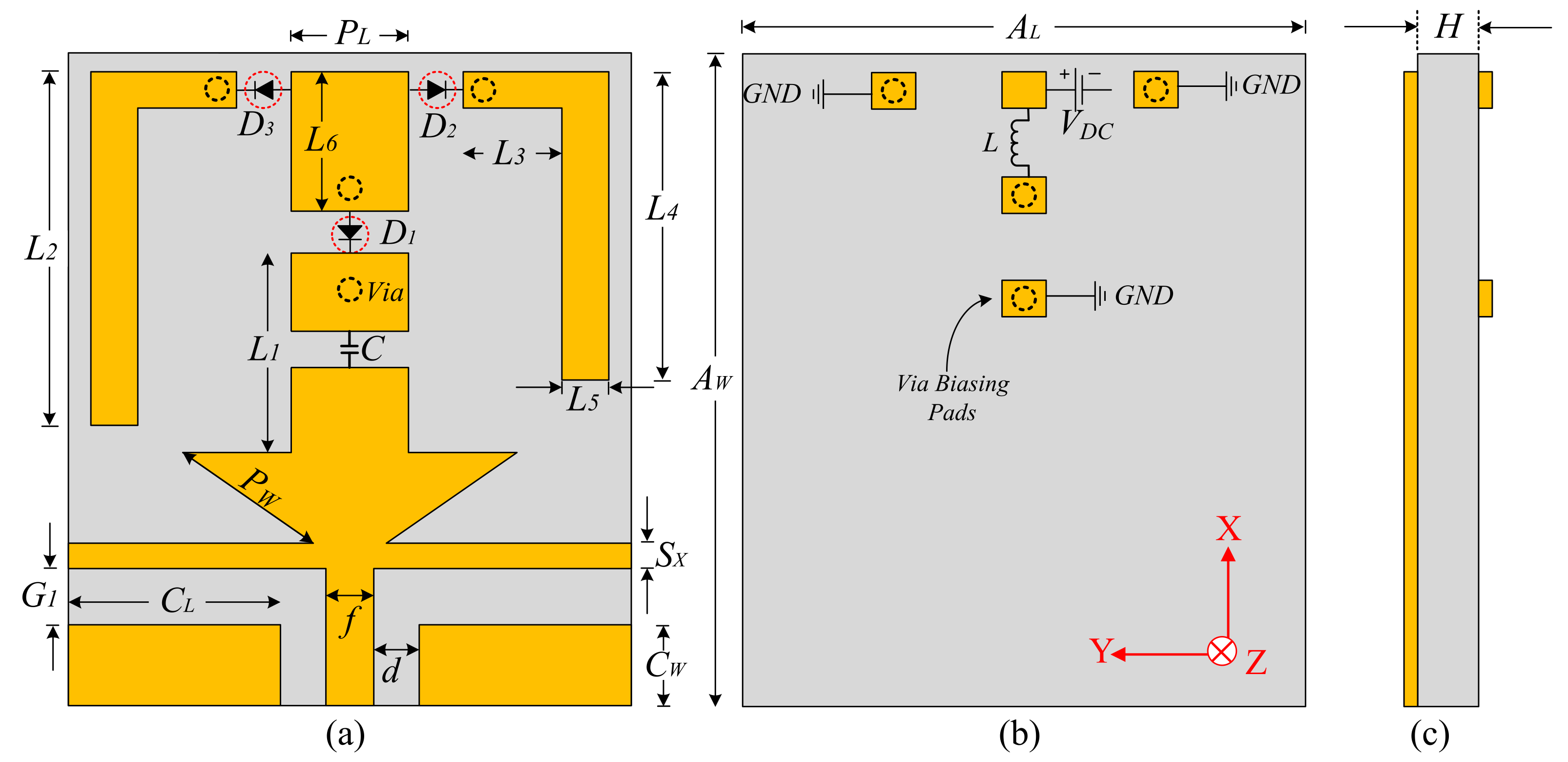
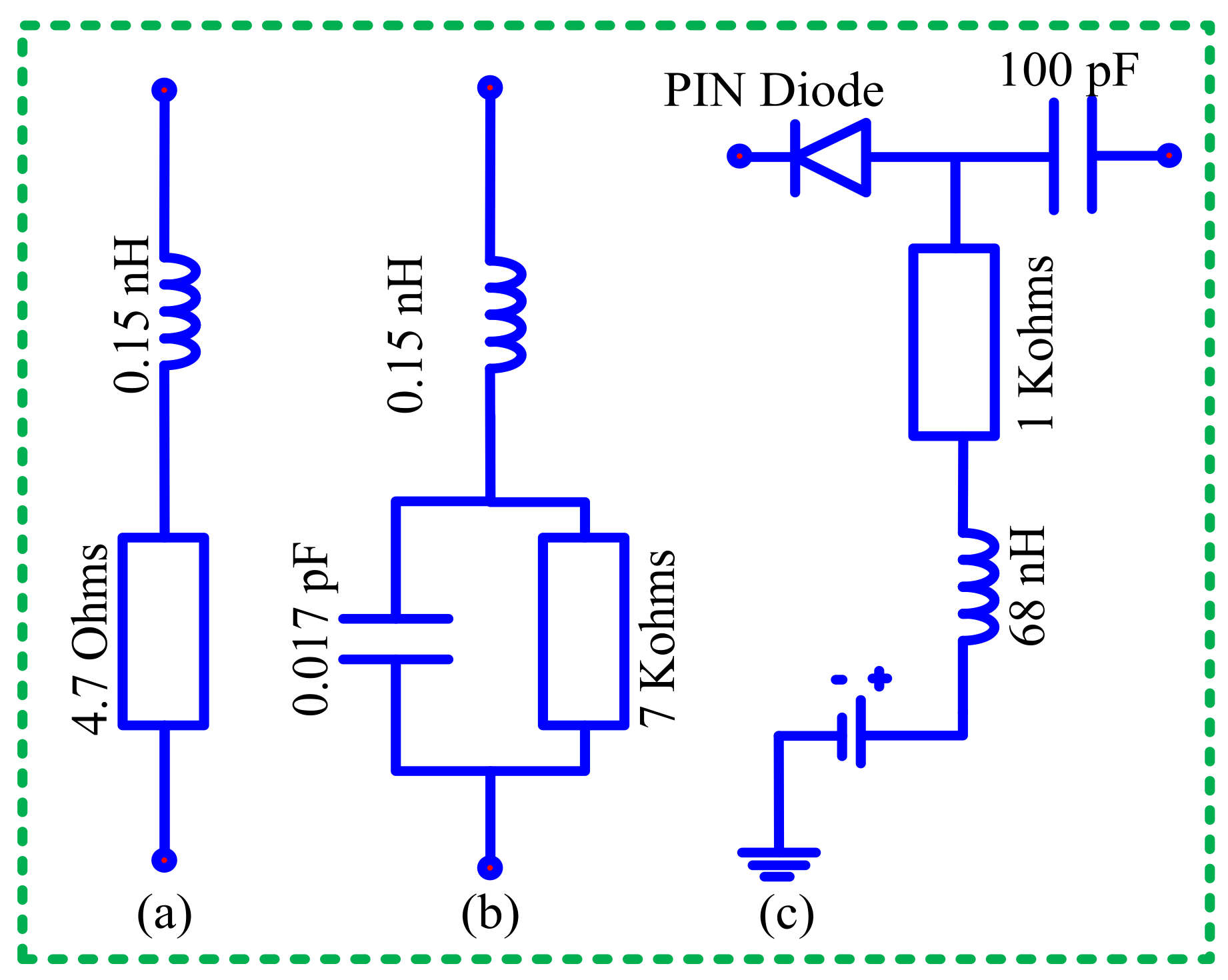

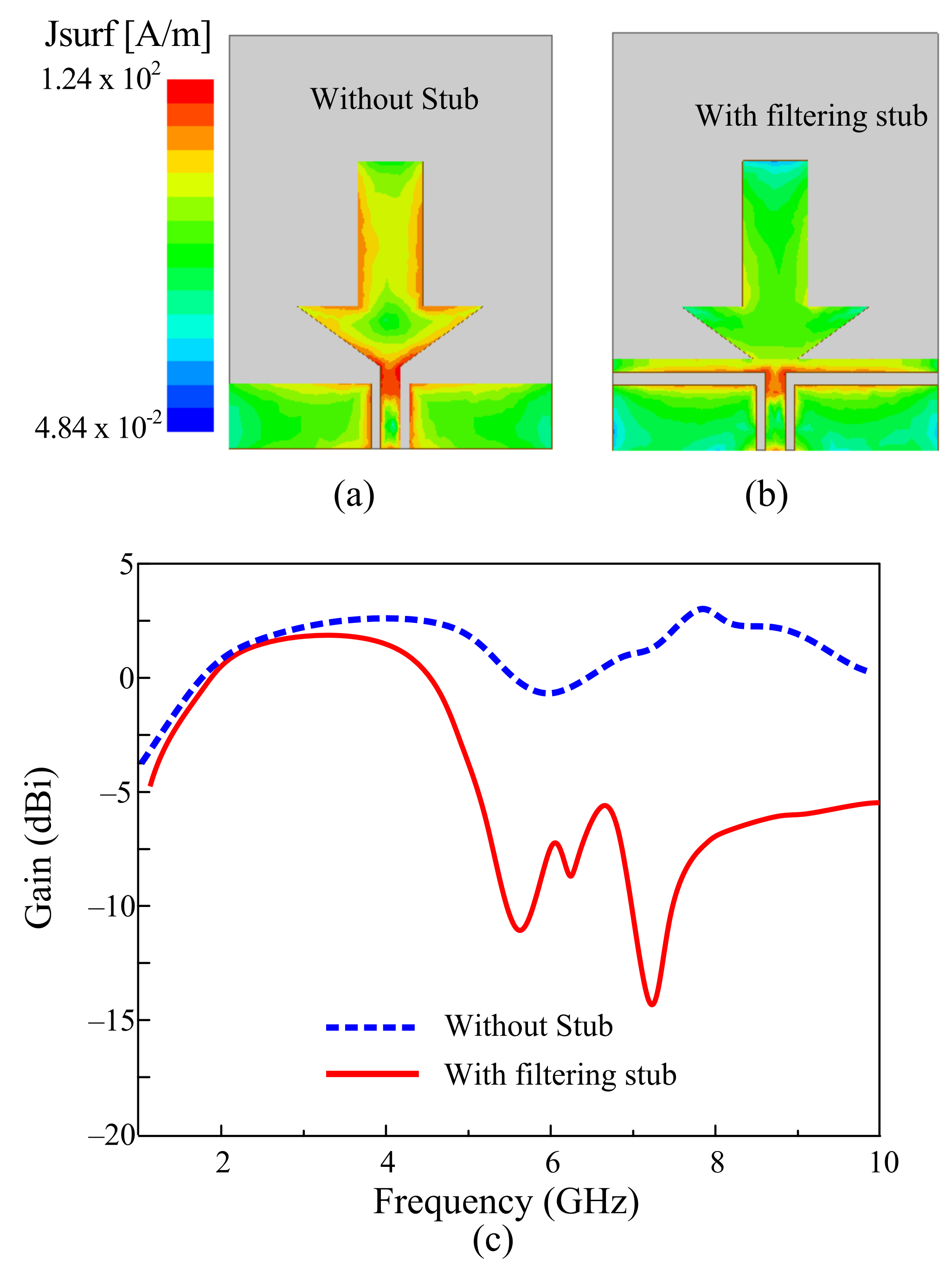
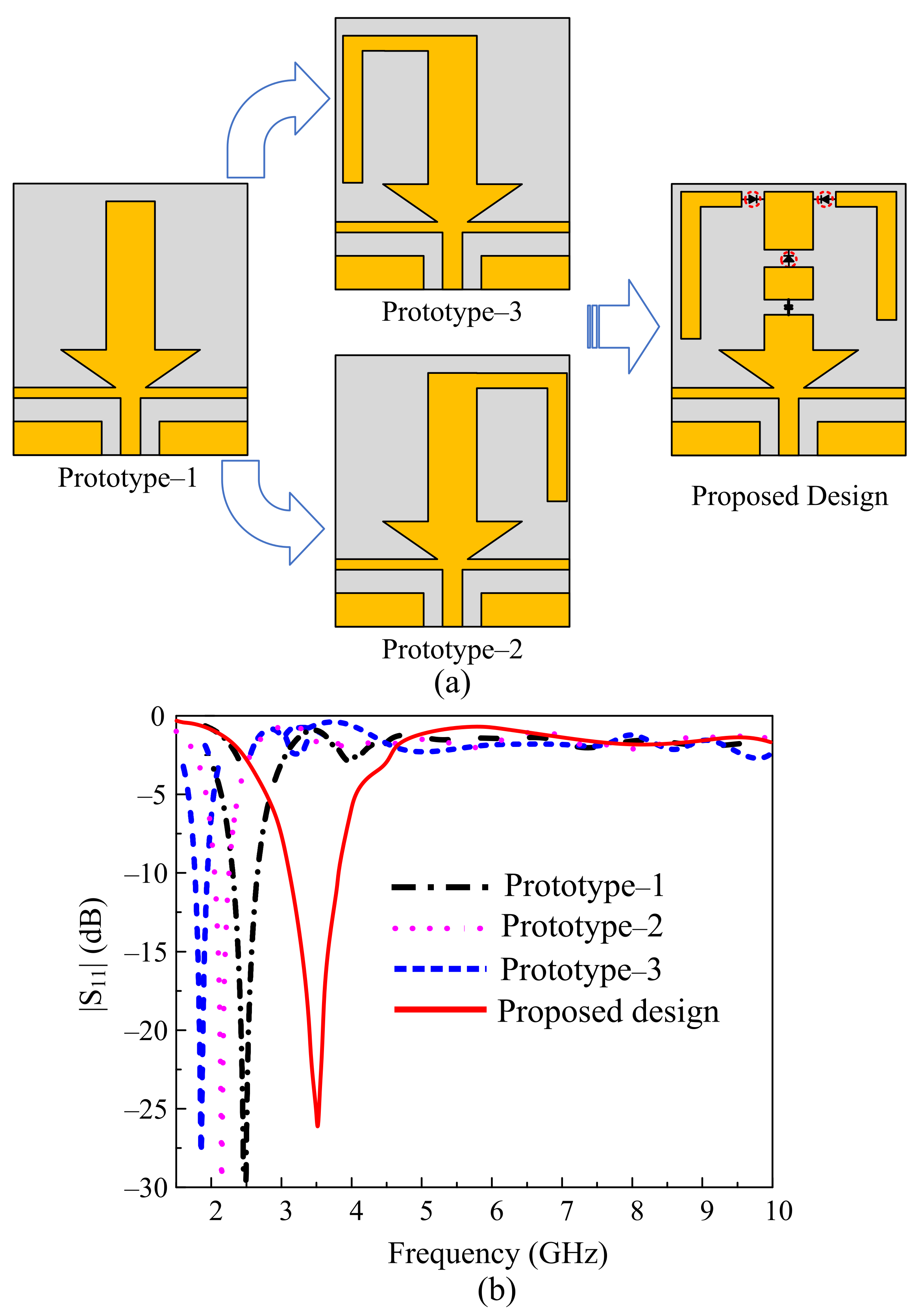


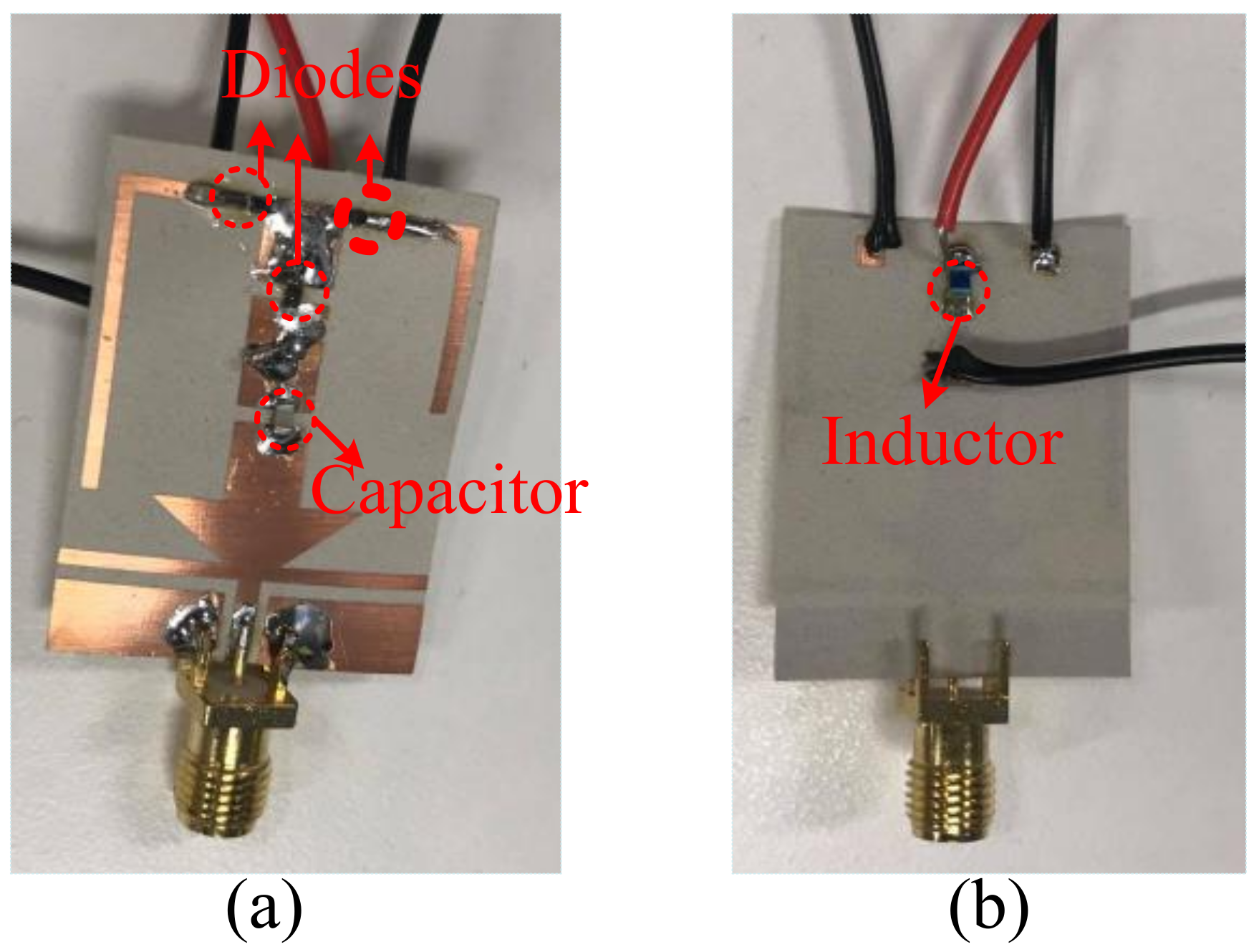

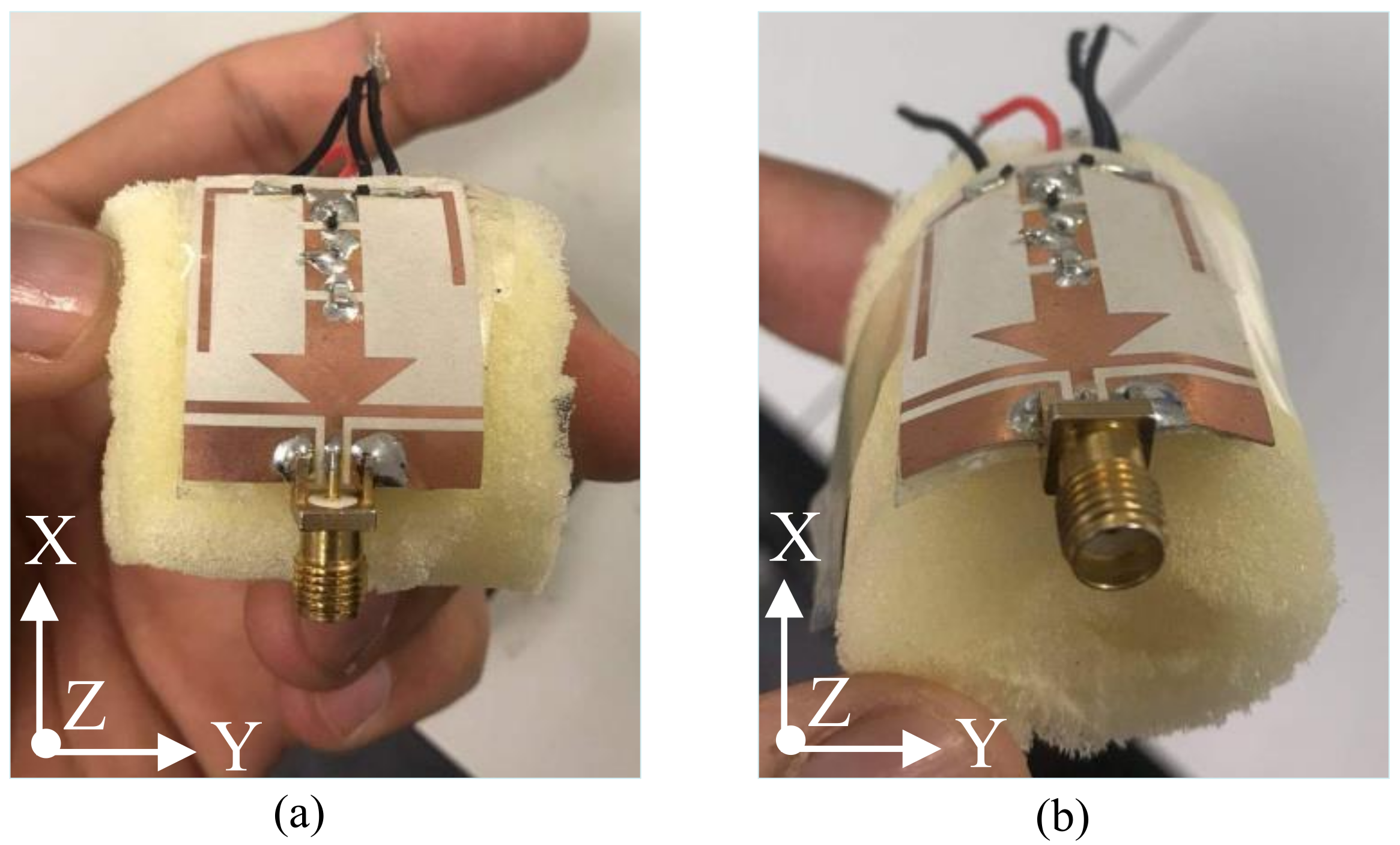
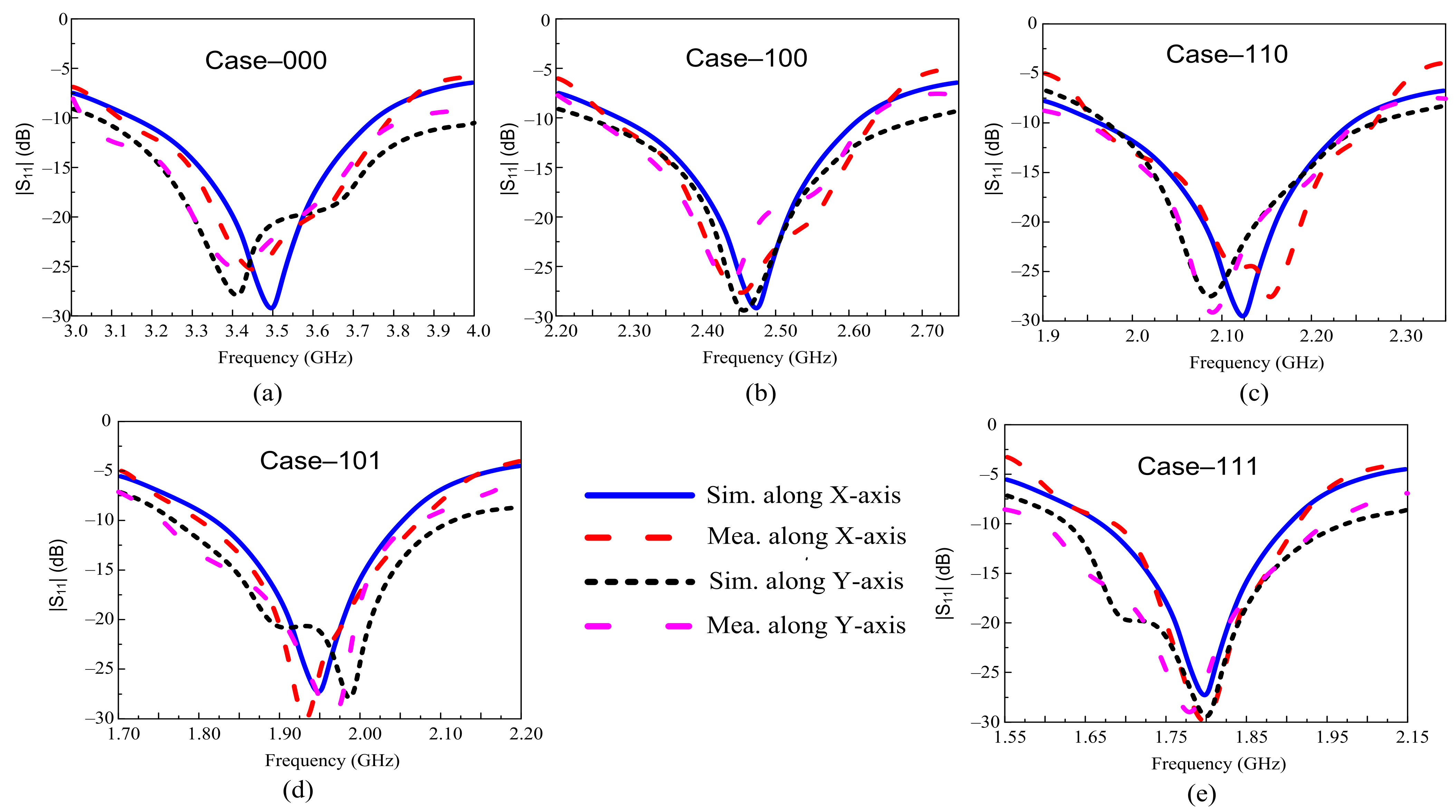
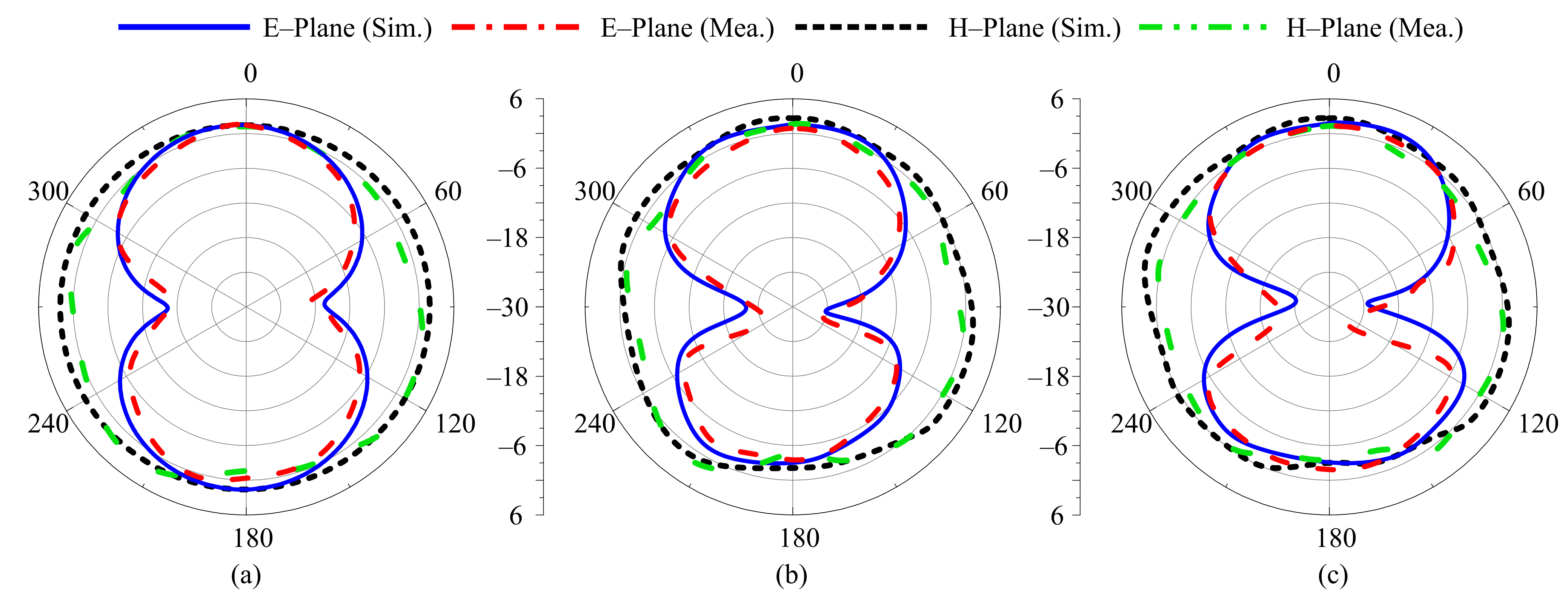
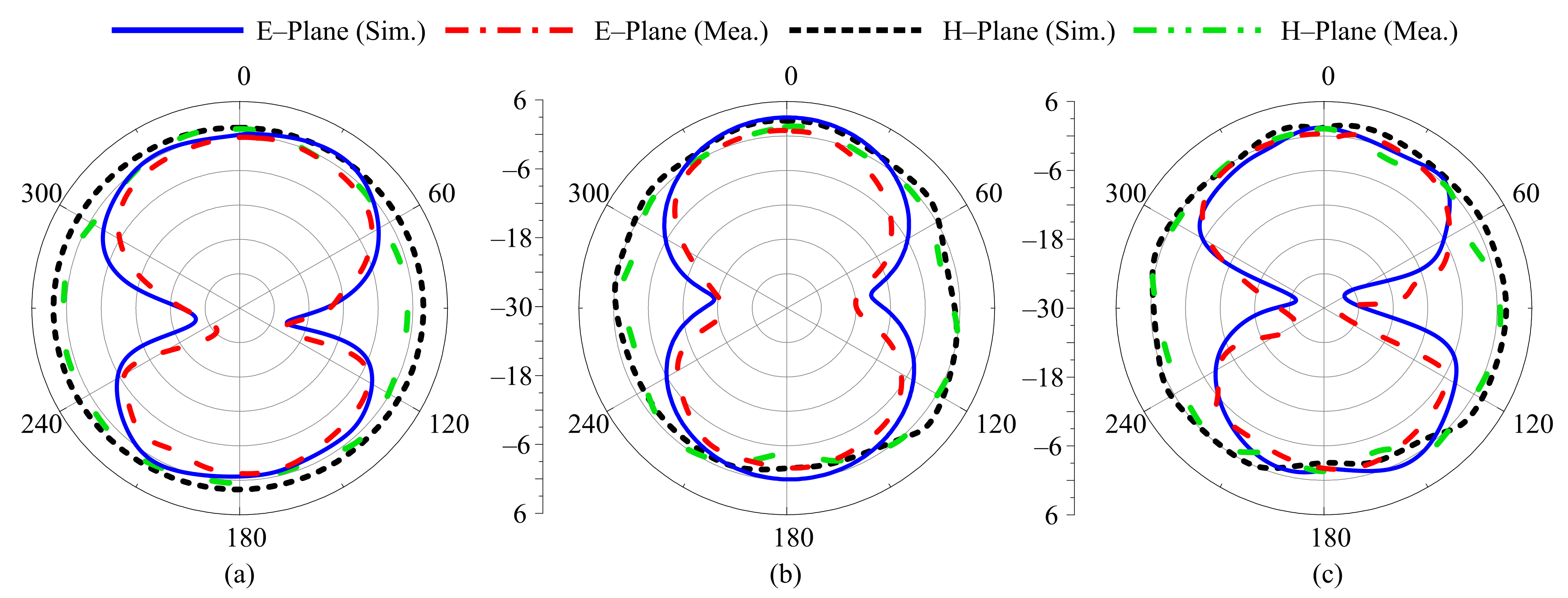


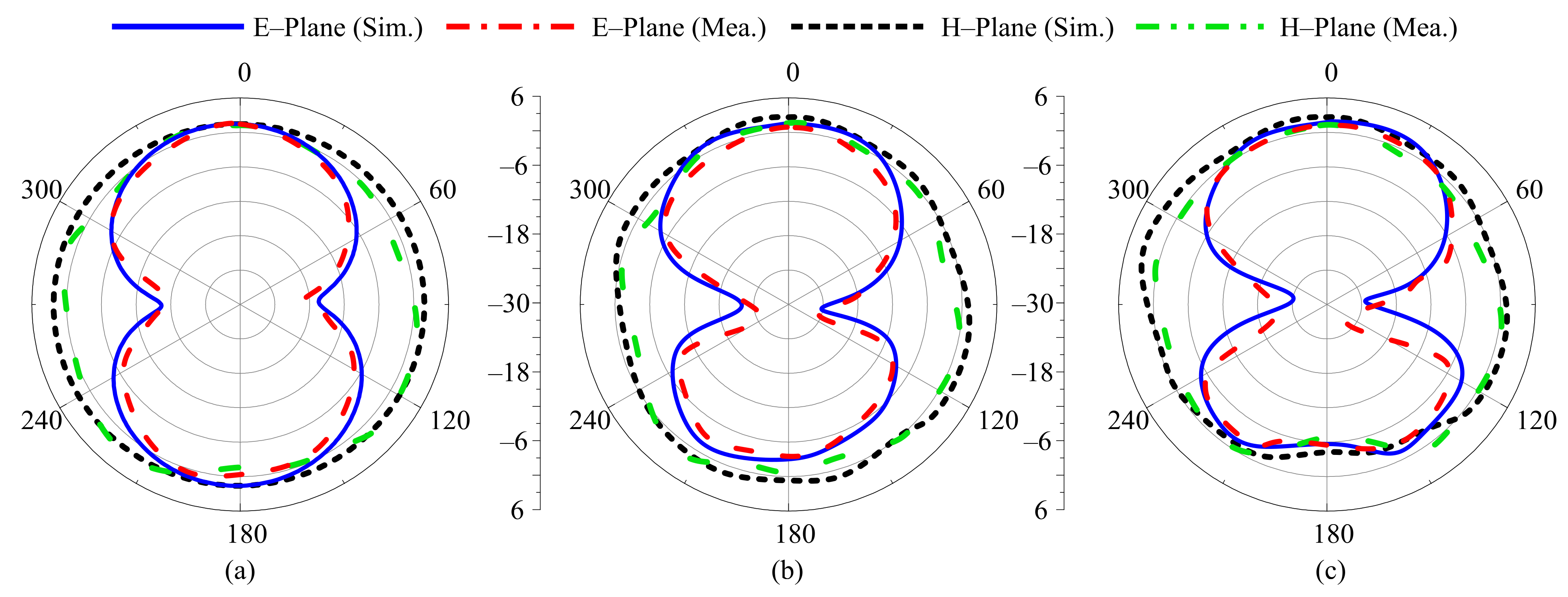

| Ref. | Size (mm3) | Resonating Frequency (GHz) | Operational Bandwidth (GHz) | Gain (dBi) | Flexible | Reconfigurability | Harmonic Suppression |
|---|---|---|---|---|---|---|---|
| [15] | 70 × 70 × 6.6 | 5.2 | 4.85–5.65 | 2.9 | ✓ | ✗ | ✗ |
| [17] | 110 × 88 × 0.3 | 0.8 2.45 4.0 | 0.74–0.81 2.4–2.5 3.9–4.1 | - | ✓ | ✓ | ✗ |
| [18] | 89 × 83 × 1.5 | 2.45/3.3 | 2.35–2.52 3.28–3.38 | 2.6 0.6 | ✓ | ✓ | ✗ |
| [19] | 60 × 60 × 5.1 | 2.3 2.4 2.5 2.6 2.7 | 2.27–2.33 2.37–2.44 2.47–2.54 2.56–2.65 2.66–2.75 | 2.9 3 3.1 3.3 3.4 | ✓ | ✓ | ✗ |
| [20] | 59 × 31 × 0.1 | 2.36 3.64 | 2.27–2.45 3.5–3.77 | 0.7 0.79 | ✓ | ✓ | ✗ |
| [21] | 20 × 45 × 1.5 | 2.4 3.5 5.8 9.5 | 2.35–2.45 3.25–3.7 5.2–5.9 9.2–9.7 | 4.9 5.6 8.8 10 | ✓ | ✓ | ✗ |
| [22] | 24 × 19 × 1.5 | 2.4 3.8 5.6 | 2.41–2.52 3.79–3.98 5.46–5.74 | 2.3 3.3 3.96 | ✓ | ✓ | ✗ |
| [23] | 80 × 70 × 1.2 | 2.4 | 2.2–2.6 | 3.3 | ✗ | ✗ | ✓ |
| [24] | 78 × 50 × 0.51 | 2.45 | 2.3–2.55 | 5 | ✗ | ✗ | ✓ |
| [25] | 60 × 26 × 1.8 | 2.45 | 1.99–2.66 | - | ✗ | ✗ | ✓ |
| [26] | 40 × 12 × 1.6 | 2.45 | 2.19–2.78 | 2.28 | ✗ | ✗ | ✓ |
| [27] | 72 × 72 × 3 | 3.7 4.8 | 3.24–4.03 4.44–5.77 | 6.8 8 | ✗ | ✓ | ✓ |
| [28] | 40 × 55 × 0.25 | 1.4 3 | 1.375–1.425 2.75–3.25 | - | ✓ | ✓ | ✓ |
| This Work | 32 × 25 × 0.25 | 1.8 1.9 2.1 2.45 3.5 | 1.66–1.93 1.81–2.05 2.02–2.29 2.27–2.64 3.17–3.82 | 2.34 2.74 3.02 3.12 3.2 | ✓ | ✓ | ✓ |
Publisher’s Note: MDPI stays neutral with regard to jurisdictional claims in published maps and institutional affiliations. |
© 2022 by the authors. Licensee MDPI, Basel, Switzerland. This article is an open access article distributed under the terms and conditions of the Creative Commons Attribution (CC BY) license (https://creativecommons.org/licenses/by/4.0/).
Share and Cite
Awan, W.A.; Hussain, N.; Kim, S.; Kim, N. A Frequency-Reconfigurable Filtenna for GSM, 4G-LTE, ISM, and 5G Sub-6 GHz Band Applications. Sensors 2022, 22, 5558. https://doi.org/10.3390/s22155558
Awan WA, Hussain N, Kim S, Kim N. A Frequency-Reconfigurable Filtenna for GSM, 4G-LTE, ISM, and 5G Sub-6 GHz Band Applications. Sensors. 2022; 22(15):5558. https://doi.org/10.3390/s22155558
Chicago/Turabian StyleAwan, Wahaj Abbas, Niamat Hussain, Sunggoo Kim, and Nam Kim. 2022. "A Frequency-Reconfigurable Filtenna for GSM, 4G-LTE, ISM, and 5G Sub-6 GHz Band Applications" Sensors 22, no. 15: 5558. https://doi.org/10.3390/s22155558
APA StyleAwan, W. A., Hussain, N., Kim, S., & Kim, N. (2022). A Frequency-Reconfigurable Filtenna for GSM, 4G-LTE, ISM, and 5G Sub-6 GHz Band Applications. Sensors, 22(15), 5558. https://doi.org/10.3390/s22155558









